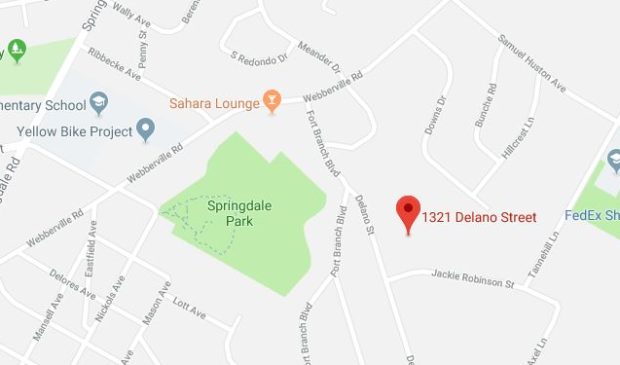Neighborhood fights for holistic infrastructure improvements on east side rezoning
Friday, January 26, 2018 by
Joseph Caterine Less than a week after the Planning Commission held a CodeNEXT discussion on the predicament of upzoning in areas with insufficient infrastructure, it had the opportunity to weigh in on a real-life example. At their Jan. 23 meeting, commissioners voted to approve staff’s recommendation for an east side residential rezoning, but complications concerning transportation prompted conditions being attached to the motion.
The confusion arose from a discrepancy in the anticipated intensity of the proposed housing project at 1321 Delano St. and 5600 Jackie Robinson St. According to a neighborhood traffic analysis, the number of daily vehicle trips generated by the 12 buildings in the applicant’s conceptual plan did not exceed acceptable limits. However, staff’s evaluation of daily trips generated by a full build-out of the site at the requested Townhouse & Condominium Residence (SF-6) zoning would.
“This means we don’t have a final decision,” Scott James with the Development Services Department said at the meeting, “and we really would prefer to wait until we have one (traffic analysis) that all parties can respond to definitively, including the fiscal participation or the off-site improvements to be built by the applicant.”
Jim Wittliff, representing applicant Evangelo Sgarbi, said that the neighborhood traffic analysis had dragged the case “into the abyss.” He told the commission that his client had agreed to retain 31 hardwood trees and build ADA ramps at the intersection of Delano Street (adjacent to the property) and Fort Branch Boulevard, a detention pond, and off-site sidewalks along Delano. A possible alternative to the applicant constructing the sidewalks was that the applicant could pay one of the affected neighborhood associations the $40,000 to construct them, but Commissioner Tom Nuckols shot down that suggestion based on his personal experience advocating for his own neighborhood association.
“If the developer builds these sidewalks in conjunction with this development, it’s going to get done quicker, and it’s going to get done cheaper than if the neighbors were to do it,” Nuckols said.
Hog Pen Neighborhood Association President Ali Ronder said that despite the applicant’s willingness, the neighborhood still was not satisfied with the intense development being built in an area with lacking infrastructure. Commissioner James Shieh suggested that the association talk to its Council member and representatives from the Transportation Department to push for a traffic study of the entire area.
Ronder replied that they have already been doing that.
“We’re doing everything, we’re trying to look at this in a holistic way, but when these dates come up like this one – we asked for a postponement specifically so that we would have time to meet with all these people, collect the data and look at this with a broader scope,” Ronder said.
The way code is structured, improvements to streets and sidewalks follow development instead of preceding it. Wittliff said that developers would be happy to build somewhere where the infrastructure was already in place, but that unfortunately that place just doesn’t exist.
“It doesn’t exist at reasonable prices, I agree,” Commissioner Patricia Seeger said.
The traffic analysis also does not take trips that will be generated in the future by developments currently under construction into its calculations; it is more a snapshot of the present. Ronder pointed out that there were 13 other condominiums being developed on other lots in the area, but they had not triggered an analysis because of their size.
The commission voted 7-5 to approve staff’s recommendation to change the zoning from SF-3 (Family Residence) to SF-6, adding a conditional overlay to put a cap of 62 on units as well as a recommendation to prohibit truck traffic on the roads affected by the development. Commissioner Greg Anderson, who had voted in dissent, said that he was supportive of the motion, but that he thought the overlay was “silly.”
“I think it’s disrespectful for the body that just voted to call it a ‘silly’ CO,” Commissioner Nuria Zaragoza said. Anderson apologized, clarifying that he meant he thought COs in general were silly.
The Austin Monitor’s work is made possible by donations from the community. Though our reporting covers donors from time to time, we are careful to keep business and editorial efforts separate while maintaining transparency. A complete list of donors is available here, and our code of ethics is explained here.
You're a community leader
And we’re honored you look to us for serious, in-depth news. You know a strong community needs local and dedicated watchdog reporting. We’re here for you and that won’t change. Now will you take the powerful next step and support our nonprofit news organization?



